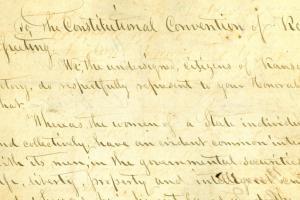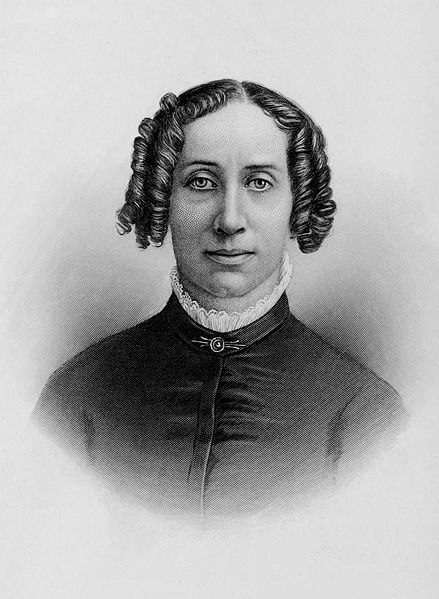
Summary
- Type: Petition
- Date: 1859
- Signatory: Charles Robinson
- Significance: Revolutionary but only partially successful demand for women's rights in Kansas
- Owning organization: Kansas Historical Society
- Related history: Wyandotte Constitution; Clarina I.H. Nichols; Sara Robinson
By Jason Roe, Kansas City Public Library
The Featured Document Blog places the past in your grasp by introducing a compelling item from our digital collection.
Context
Married women in Kansas Territory, like others across the United States, could not legally vote, testify in court, serve on juries, hold most political offices, or even own property. Rather, in accordance with the legal concept of "coverture," which dated back to English common law, an individual woman's rights were supposed to be indistinguishable and subservient to her father's or husband's rights. In the event of divorce, the husband usually received full property rights and custody over children. Only by remaining single into adulthood or through widowhood could most women own property.
Because the law viewed husband and wife as one legal entity, a wife could not press charges against her husband in domestic violence or civil cases (except for the most physically injurious assaults), nor against anyone else without her husband pressing charges on her behalf. While husbands did not possess absolute power over their wives as human property, as in a master and slave relationship, it was generally accepted that they had a legal right to beat and rape their wives. Across the United States, so-called "marital rape" only became uniformly illegal as individual states outlawed it between 1975 and 1993, more than 100 years after this petition sought to eliminate all "constitutional distinctions based upon sex" in Kansas.
Document
This 1859 petition, owned by the Kansas Historical Society, sought to revolutionize the status of women in the future state of Kansas by requesting that the Wyandotte Constitutional Convention of Kansas Territory grant women the “Legal and Constitutional guarantees enjoyed by any class of citizens.” While the document does not outline individual rights sought by the petitioners, its broad demand for legal equality was well ahead of its time and corresponded with the radical abolitionist movement in Kansas.
From the petition:
"We the undersigned, being of mature age, do respectfully petition and protest against any constitutional distinctions based upon sex."
One of the most prominent signatories of the petition was Charles Robinson, a Free-State Party leader who by this time had been appointed territorial governor by the legally unrecognized Topeka legislature and arrested for treason, only to be released several months later. He went on to become the first governor of the state of Kansas in February 1861.
Equally notable was Charles’s wife, Sara Robinson, who was born Sara Tappan Doolittle Lawrence, a relative of the abolitionist (and namesake of Lawrence, Kansas) Amos Lawrence. Sara most famously penned the 1856 book, Kansas: Its Interior and Exterior Life, which emerged as a definitive account of Bleeding Kansas. While Robinson’s book is no longer a household name, contemporary readers considered it nearly as important as Uncle Tom’s Cabin, by Harriet Beecher Stowe, in galvanizing the abolitionist movement.
The petition itself may have been a close relative or perhaps a duplicate of a petition authored by Clarina Nichols, who was a key figure in the constitutional convention held at Wyandotte on July 5, 1859. Ultimately, the Wyandotte Constitution, which became the constitution of the state of Kansas, rejected the demands of this petition, but it did grant the right of women to voting rights in school district elections, to equal custody of their children, and to property ownership – all of which were nationally-notable advances. The convention also considered but rejected suffrage for blacks and Native Americans.
The fact that this petition for women’s rights emerged out of the antislavery cause in Kansas reflects the deep intersection of abolitionists, temperance reformers, and women’s rights activists in mid-19th century America. Ultimately, Kansas women had to wait decades for suffrage and many other legal rights, but the state did maintain a reputation for liberal reform for the next half-century. Besides entering the Union as a free state in 1861, Kansas granted women the right to vote in municipal elections in 1887 and was the home of the radical Populist Movement in the 1890s.
Kansas women finally received full suffrage rights in 1912, eight years before the 19th Amendment extended this right to all American women, but even in Kansas, women would have to win other rights gradually as the 20th century progressed.
Additional Resources
Eickhoff, Diane. Revolutionary Heart: The Life of Clarina Nichols and the Pioneering Crusade for Women's Rights. Kansas City, Kansas: Quindaro Press, 2006.
Robinson, Sara T.D. Kansas, Its Interior and Exterior Life: Including a Full View of its Settlement, Political History, Social Life, Climate, Soil, Productions, Scenery, Etc. Boston: Crosby, Nichols and Company, 1856.


